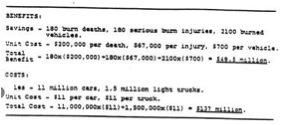Is safer patient care profitable?
Readers might recall the Ford Pinto case surrounding the safety of its fuel tank design. In this case, it was alleged:
The gas tank in the Pinto was known by Ford engineers to be defective. If a Pinto was rear-ended at under 30mph, there was a likelihood that the gas tank would be torn open by protruding bolts, causing gasoline to pour into the car’s interior. At 40mph, the same thing would happen… except the doors would also be jammed shut and people would be trapped in their burning Pinto.
Proof for this claim came from the following memo which shows that the cost of fixing the problem was $137 million and the “savings” from doing nothing was $49.5 million:
Could this same thinking be happening in hospitals? Please tell us what you think.
Hospitals Profit From Surgical Errors
Thanks to @nursefriendly for pointing out a recent study discussed in the New York Times.
In a recent study published in JAMA (Journal of American Medical Association), researchers found that “hospitals “make money from their own mistakes because insurers pay them for the longer stays and extra care that patients need to treat surgical complications that could have been prevented.”
The New York Times reported:
Changing the payment system, to stop rewarding poor care, may help to bring down surgical complication rates, the researchers say. If the system does not change, hospitals have little incentive to improve: in fact, some will wind up losing money if they take better care of patients.
The Value of Safer Care
However, in a survey by Altarum Institute and Drexel University found that “most respondents would choose a hospital with a higher patient safety rating, even if it meant paying an additional $1000 in out-of-pocket costs.”
Writes Peter J. Pronovost, MD, PhD, FCCM, Professor, Departments of Anesthesiology/Critical Care Medicine and Surgery, The Johns Hopkins University School of Medicine and Medical Director, Center for Innovation in Quality Patient:
If you’re shopping for a new car, you could quickly track down the well-tested, simple safety ratings from the Insurance Institute for Highway Safety or the National Highway Traffic Safety Administration. People know that good ratings mean less chance of death or serious injury should they have an auto accident, as well as an increased ability to avoid crashes in the first place. A low rating certainly is a red flag when you’re considering a particular model. For patients selecting a hospital, safety ratings should one day be treated the same way.

